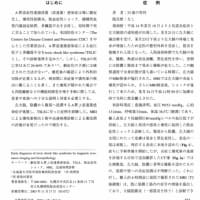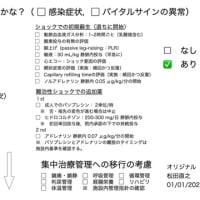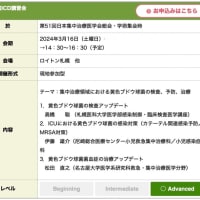Fibrosis--a common pathway to organ injury and failure.
Rockey DC, Bell PD, Hill JA.
N Engl J Med. 2015;372:1138-49.
<松田直之 コメント>
現在,当講座が全身管理として注目している病態は,炎症後の臓器内線維症です。
この診療および研究が重要と評価し,特に線維芽細胞のリセッティングをターゲットとした研究も推進中です。
救急・集中治療領域における新規病態学・創薬のターゲットと考えています。
炎症を軽減する方策を戦略化一方で,炎症後の線維化増強を正常化させるのです。
当講座は,2015年春季抄読会で,この総説を取り上げる予定です。
Disease-related injury in any organ triggers a complex cascade of cellular and molecular responses that culminates in tissue fibrosis. Although this fibrogenic response may have adaptive features in the short term, when it progresses over a prolonged period of time, parenchymal scarring and ultimately cellular dysfunction and organ failure ensue.
We and others have proposed four major phases of the fibrogenic response. First is initiation of the response, driven by primary injury to the organ. The second phase is the activation of effector cells, and the third phase is the elaboration of extracellular matrix, both of which overlap with the fourth phase, during which the dynamic deposition (and insufficient resorption) of extracellular matrix promotes progression to fibrosis and ultimately to end-organ failure.
The fact that diverse diseases in different organ systems are associated with fibrotic changes suggests common pathogenic pathways. This “wounding response” is orchestrated by complex activities within different cells in which specific molecular pathways have emerged. Cellular constituents include inflammatory cells (e.g., macrophages and T cells), epithelial cells, fibrogenic effector cells, endothelial cells, and others. Many different effector cells, including fibroblasts, myofibroblasts, cells derived from bone marrow, fibrocytes, and possibly cells derived from epithelial tissues (epithelial-to-mesenchymal transition) have been identified; there is some controversy regarding the identity of specific effectors in different organs. Beyond the multiple cells essential in the wounding response, core molecular pathways are critical; for example, the transforming growth factor beta (TGF-β) pathway is important in virtually all types of fibrosis.
As fibrosis progresses, myofibroblasts proliferate and sense physical and biochemical stimuli in the local environment by means of integrins and cell-surface molecules; contractile mediators trigger pathological tissue contraction. This chain of events, in turn, causes physical organ deformation, which impairs organ function. Thus, the biology of fibrogenesis is dynamic, although the degree of plasticity appears to vary from organ to organ.
Although we understand many of the cellular and molecular processes underlying fibrosis, there are few effective therapies and fewer that target fibrogenesis specifically. These facts highlight the need for a deeper comprehension of the pathogenesis of fibrogenesis and the translation of this knowledge to novel treatments.



Rockey DC, Bell PD, Hill JA.
N Engl J Med. 2015;372:1138-49.
<松田直之 コメント>
現在,当講座が全身管理として注目している病態は,炎症後の臓器内線維症です。
この診療および研究が重要と評価し,特に線維芽細胞のリセッティングをターゲットとした研究も推進中です。
救急・集中治療領域における新規病態学・創薬のターゲットと考えています。
炎症を軽減する方策を戦略化一方で,炎症後の線維化増強を正常化させるのです。
当講座は,2015年春季抄読会で,この総説を取り上げる予定です。
Disease-related injury in any organ triggers a complex cascade of cellular and molecular responses that culminates in tissue fibrosis. Although this fibrogenic response may have adaptive features in the short term, when it progresses over a prolonged period of time, parenchymal scarring and ultimately cellular dysfunction and organ failure ensue.
We and others have proposed four major phases of the fibrogenic response. First is initiation of the response, driven by primary injury to the organ. The second phase is the activation of effector cells, and the third phase is the elaboration of extracellular matrix, both of which overlap with the fourth phase, during which the dynamic deposition (and insufficient resorption) of extracellular matrix promotes progression to fibrosis and ultimately to end-organ failure.
The fact that diverse diseases in different organ systems are associated with fibrotic changes suggests common pathogenic pathways. This “wounding response” is orchestrated by complex activities within different cells in which specific molecular pathways have emerged. Cellular constituents include inflammatory cells (e.g., macrophages and T cells), epithelial cells, fibrogenic effector cells, endothelial cells, and others. Many different effector cells, including fibroblasts, myofibroblasts, cells derived from bone marrow, fibrocytes, and possibly cells derived from epithelial tissues (epithelial-to-mesenchymal transition) have been identified; there is some controversy regarding the identity of specific effectors in different organs. Beyond the multiple cells essential in the wounding response, core molecular pathways are critical; for example, the transforming growth factor beta (TGF-β) pathway is important in virtually all types of fibrosis.
As fibrosis progresses, myofibroblasts proliferate and sense physical and biochemical stimuli in the local environment by means of integrins and cell-surface molecules; contractile mediators trigger pathological tissue contraction. This chain of events, in turn, causes physical organ deformation, which impairs organ function. Thus, the biology of fibrogenesis is dynamic, although the degree of plasticity appears to vary from organ to organ.
Although we understand many of the cellular and molecular processes underlying fibrosis, there are few effective therapies and fewer that target fibrogenesis specifically. These facts highlight the need for a deeper comprehension of the pathogenesis of fibrogenesis and the translation of this knowledge to novel treatments.






























